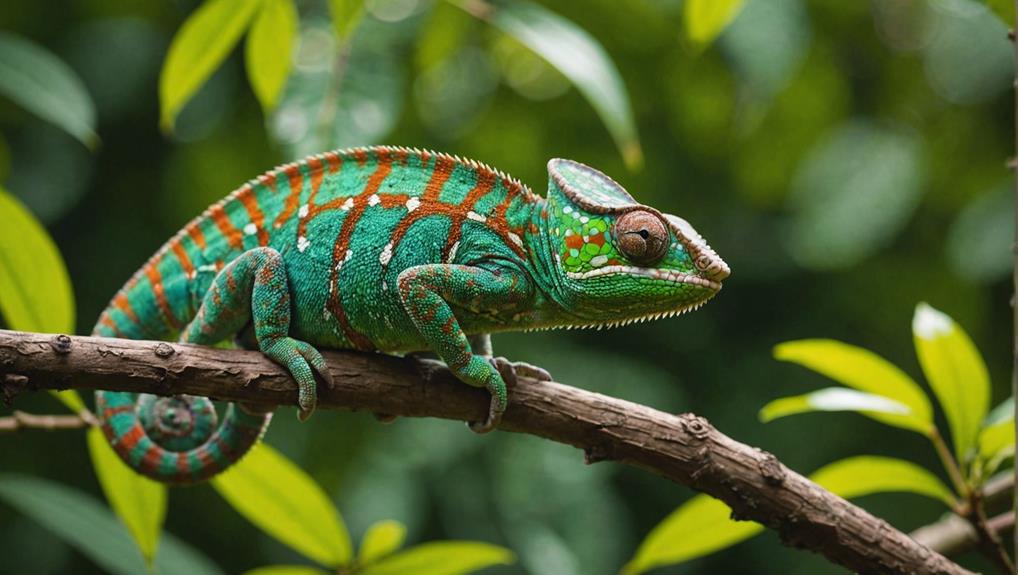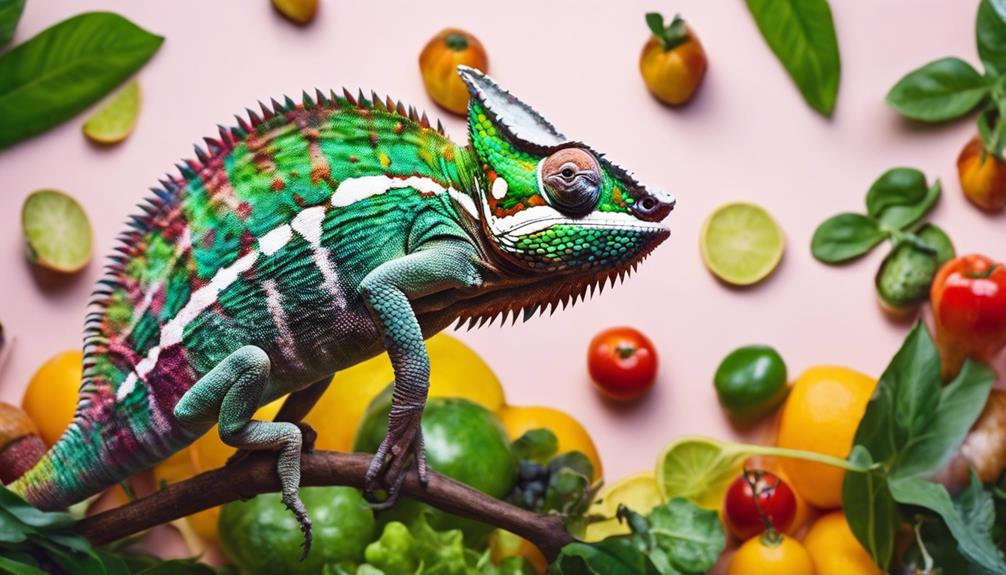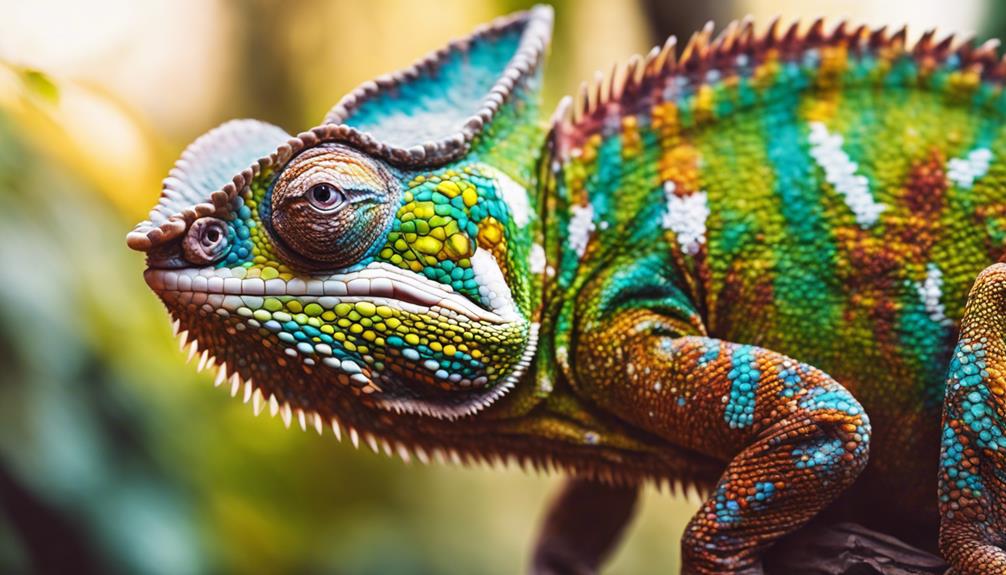Meet the Oustalet Chameleon: A Giant Among Its Kind
Reaching lengths of up to 27 inches, the Oustalet chameleon is one of the largest species of chameleons, native to Madagascar.
They thrive in varied habitats, from rainforests to arid forests, and have the remarkable ability to change colors for camouflage and emotional signaling.
To care for an Oustalet chameleon, you'll need a spacious, well-ventilated terrarium with live plants and a diet rich in insects like crickets and mealworms.
Proper hydration, achieved through misting, is essential.
These solitary and territorial creatures thrive best with minimal handling.
With the right care, Oustalet chameleons can live 5-10 years.
They have unique behaviors and specific care requirements that are essential for a healthy life.
By understanding their needs, you can provide the perfect environment for your Oustalet chameleon to flourish.
Natural Habitat
The Oustalet chameleon thrives in the diverse ecosystems of Madagascar.
You'll find this fascinating creature spread across the island's expansive landscapes, showcasing a remarkable geographic distribution. From the lush rainforests to the arid, spiny forests, these chameleons have adapted to a variety of environments, making them a true symbol of Madagascar's rich biodiversity.
If you're curious about their climate preferences, you should know that Oustalet chameleons are highly adaptable. They're comfortable in both humid and dry conditions, a trait that allows them to inhabit such varied regions. However, they do have a slight preference for warmer temperatures, often found basking in the sunlight to regulate their body temperature.
This adaptability means they're not confined to one specific type of habitat, giving them the freedom to explore and thrive in different areas.
When considering their geographic distribution, you'll notice that these chameleons aren't limited to remote forests. They can also be spotted in more open areas, such as savannas and agricultural fields.
This wide distribution helps them avoid competition and predators, ensuring their survival across the island.
Physical Characteristics
The Oustalet chameleon's striking physical characteristics set it apart from other species. This fascinating reptile is among the largest chameleons in the world, making an impressive statement with its size. When you see an Oustalet chameleon, you'll notice its body can reach up to 27 inches in length, putting it in a league of its own when you do a size comparison with other chameleons.
One of the most striking features is the chameleon's distinctive scales. These scales aren't just for show; they provide protection and aid in blending into their surroundings. The texture and arrangement of these scales give the Oustalet chameleon a rugged, almost armored appearance. When you touch or observe these scales closely, you can see how they're uniquely adapted to their environment.
The Oustalet chameleon also has a prehensile tail, which it uses skillfully to grasp branches and maintain balance as it climbs. This tail is an essential tool for their arboreal lifestyle, allowing them to move freely and securely through the trees. Their feet are specially adapted as well, with zygodactylous toes that grip branches tightly, giving them a strong hold in their natural habitat.
Another notable physical characteristic is their eyes, which can move independently of each other. This gives them a 360-degree field of vision, allowing them to spot prey and predators with remarkable efficiency. These features combined make the Oustalet chameleon a master of its environment, perfectly adapted to a life of freedom and exploration.
Color Variations
You'll notice that the Oustalet Chameleon can change its colors naturally, adapting to various surroundings.
These color shifts are influenced by environmental factors such as light, temperature, and mood.
Understanding these variations helps you appreciate how these remarkable creatures interact with their habitat.
Natural Color Changes
Witnessing the Oustalet Chameleon's natural color changes is like observing a living canvas in constant transformation.
These changes aren't just for show; they serve essential purposes. The Oustalet Chameleon uses its color-changing abilities as a camouflage mechanism. By blending into its surroundings, it can hide from predators and sneak up on prey.
Additionally, these color shifts can signify emotional signaling. When a chameleon feels threatened or is in a confrontational situation, its colors will often become more vibrant and intense.
To imagine these color changes, think of the following scenarios:
- Hiding among green leaves: The chameleon turns various shades of green.
- Blending with the brown bark of a tree: Its skin shifts to browns and tans.
- Feeling threatened by a predator: Bright reds and oranges appear.
- During a fight with another chameleon: Colors become bold and contrasting, such as black and white patterns.
These transformations aren't just fascinating to witness but are fundamental to the chameleon's survival and communication. You'll find that observing these natural color changes offers a glimpse into the complex and adaptive lives of these remarkable reptiles.
Influencing Environmental Factors
Environmental factors play a crucial role in the color variations of the Oustalet Chameleon. You might find that these fascinating creatures change their hues in response to various environmental cues.
Climate impact is a significant factor. When the weather shifts, so do the chameleon's colors. This isn't just about looking good; it's a survival mechanism. They adapt their coloration to blend into their surroundings, whether that's lush greenery or dry, sparse terrain.
Temperature fluctuations also greatly influence their color changes. When the temperature rises, you might notice the chameleon adopting lighter shades to reflect heat and stay cool. Conversely, cooler temperatures might prompt them to take on darker colors to absorb warmth.
This dynamic adaptability helps them regulate their body temperature and maintain peak metabolic function.
Furthermore, light exposure plays a part in their color shifts. In brighter environments, chameleons often display more vivid colors, while dimmer settings might lead to more subdued tones.
Diet and Nutrition
When caring for an Oustalet Chameleon, you'll need to focus on their insect-based primary diet, ensuring they get the necessary nutrients.
Supplements are essential to prevent deficiencies, so don't forget to include calcium and vitamins.
Additionally, proper hydration is key, so misting their enclosure and providing a drip system will keep them healthy.
Insect-Based Primary Diet
The Oustalet chameleon thrives on a diet primarily composed of a variety of insects, ensuring it gets the necessary nutrients for survival.
Living in diverse climate conditions from dry forests to humid rainforests, these chameleons adapt their diet according to their environment.
Human interactions, such as habitat encroachment, can sometimes influence the availability of prey, making their diet even more vital for their well-being.
In their natural habitat, Oustalet chameleons enjoy a smorgasbord of insects.
Crickets – These are a staple, providing high protein and easy availability.
Roaches – A hearty meal that offers a good balance of nutrients.
Grasshoppers – They love these, especially in the wild where they're abundant.
Mealworms – These larvae are a tasty treat, often given in captivity.
Your chameleon will appreciate the freedom to hunt and devour these insects, mirroring its natural behavior.
Ensuring a varied diet not only keeps them healthy but also allows them to thrive in both wild and captive environments.
Nutritional Supplement Needs
While a varied insect diet forms the backbone of an Oustalet chameleon's nutrition, they still need additional supplements to stay healthy.
To promote your chameleon's well-being, you should focus on gut loading and vitamin supplementation.
Gut loading involves feeding nutritious foods to the insects you'll offer your chameleon. This boosts the nutritional value of the insects, making them more beneficial for your pet.
You can use foods like leafy greens, carrots, and sweet potatoes for gut loading. Make sure to do this about 24 hours before offering the insects to your chameleon.
Vitamin supplementation is also essential.
Dust your chameleon's insects with a calcium supplement at least three times a week. Additionally, provide a multivitamin supplement once a week.
This guarantees your chameleon gets essential nutrients like vitamin D3, which is necessary for calcium absorption and overall health.
Hydration Sources and Methods
Maintaining your Oustalet chameleon's hydration is vital for its health and well-being. These fascinating reptiles have unique ways of getting their water.
Let's explore the best hydration sources and methods to keep your chameleon thriving.
Rain Collection: Mimicking natural rain is a great way to hydrate your chameleon. Use a misting system to simulate rainfall in the enclosure. This helps them drink just like they'd in the wild.
Dew Licking: Oustalet chameleons love licking dew from leaves. To replicate this, mist the enclosure's plants in the morning and evening. This creates droplets that your chameleon will enthusiastically lap up.
Drippers: A dripper system is another excellent method. It provides a slow, steady drip of water that mimics rain collection. Place it above the plants so droplets can collect on the leaves for your chameleon to drink.
Water Bowls: Though not as natural, a shallow water bowl can be placed in the enclosure. Just guarantee it's clean and changed regularly to prevent any bacteria buildup.
Mating and Reproduction
During the breeding season, male Oustalet chameleons engage in vibrant displays to attract potential mates. They change their colors more frequently and perform elaborate courtship rituals to win over the females. These displays aren't just for show; they communicate the male's health and genetic fitness, helping the female decide on the best partner.
Once a female has chosen her mate, the actual mating process can begin. It usually starts with the male approaching the female cautiously before making physical contact. If the female is receptive, she'll allow the male to mate with her. This process is brief but essential for the continuation of the species.
After mating, the female Oustalet chameleon will focus on finding a suitable place to lay her eggs. She'll dig a small hole in the ground to deposit her eggs, which she then covers up to protect them from predators. The egg incubation period can last several months, depending on the environmental conditions such as temperature and humidity. During this time, it's imperative that the eggs remain undisturbed to allow the embryos to develop properly.
As the eggs incubate, you won't need to intervene much, if at all. Nature has equipped these creatures with everything they need to bring new life into the world. Just maintain an environment that mimics their natural habitat as closely as possible, keeping an eye on temperature and humidity levels. When the time is right, the baby chameleons will hatch, ready to start their own journeys.
Behavior and Temperament
Oustalet chameleons are known for their solitary and territorial nature, often displaying assertive behaviors to defend their space. Unlike many animals that thrive on social interactions, Oustalet chameleons prefer to live alone. They often view other chameleons as intruders, leading to aggressive displays to ward off potential threats. This territorial behavior is vital to having ample resources and space to themselves.
When it comes to stress responses, Oustalet chameleons can be quite sensitive. They may exhibit color changes, become more aggressive, or even refuse to eat if they feel threatened or overcrowded. Understanding their need for solitude is essential to keeping them healthy and stress-free.
They might display the following behaviors:
- Color Changes: They might change colors dramatically to signal stress or assert dominance.
- Posturing: Expect to see them puffing up their bodies and spreading their limbs to appear larger.
- Hissing: They can produce a hissing sound to deter perceived threats.
- Retreating: Sometimes, they'll simply retreat to a secluded spot in their habitat.
Handling them too frequently can lead to significant stress responses. While they might tolerate occasional interaction, prolonged or frequent handling isn't ideal. Their natural inclination is to be left alone, exploring and climbing in their environment at their own pace, which allows them to maintain a sense of security and protect their territory.
Health and Lifespan
Maintaining the health of your Oustalet chameleon is essential for guaranteeing they enjoy a long and healthy lifespan. By staying vigilant and proactive, you can help your chameleon thrive. In captivity, an Oustalet chameleon can live anywhere from 5 to 10 years, depending on the quality of care they receive.
Let's explore the common illnesses and how to keep your chameleon in peak condition.
First, it's vital to watch for signs of dehydration. Chameleons need a consistent source of water, often provided through misting or drip systems. Dehydration can lead to more severe problems like kidney failure.
Another common illness is metabolic bone disease, resulting from a lack of calcium or insufficient UVB lighting. This condition can cause deformities and severe health issues, so provide your chameleon with proper calcium supplements and UVB exposure.
Respiratory infections are also frequent among chameleons. Symptoms include wheezing, excessive mucus, and difficulty breathing. These infections often stem from incorrect humidity levels or inadequate ventilation. If you notice any respiratory issues, visit a reptile-savvy vet immediately.
Parasites, both internal and external, can plague your chameleon. Regular fecal exams can help detect internal parasites early. For external parasites like mites, keep their habitat clean and inspect your chameleon regularly.
Lifespan predictions for your Oustalet chameleon hinge on preventing these common illnesses and maintaining ideal living conditions. Regular vet check-ups, a balanced diet, proper lighting, and humidity control are key. By staying informed and diligent, you can guarantee your chameleon lives a vibrant and healthy life under your care.
Enclosure Setup
To guarantee your Oustalet chameleon stays healthy and happy, you need to create an ideal enclosure setup that meets their specific needs.
Start by choosing a spacious, well-ventilated terrarium. A screen cage is often the best choice because it provides excellent air circulation, which is essential for your chameleon's well-being. Make certain the cage is at least 24x24x48 inches to give them ample room to climb and explore.
Selecting the right substrate is key for maintaining a clean and healthy environment.
- Paper Towels: Easy to replace and great for monitoring waste.
- Coconut Fiber: Absorbent and natural, it helps maintain humidity.
- Reptile Carpet: Washable and reusable, providing a safe surface.
- No Substrate: Simply a bare bottom for easy cleanup.
When it comes to plant selection, opt for non-toxic, live plants that can thrive in the same humidity and temperature range as your chameleon.
- Ficus Trees: Provide sturdy branches and dense foliage.
- Pothos: Hardy and excellent for climbing.
- Hibiscus: Adds vibrant color and edible flowers.
- Schefflera: Also known as the umbrella plant, it offers broad leaves and dense cover.
Lighting and temperature management are essential. Use a UVB light to mimic natural sunlight and a basking light to create a temperature gradient within the enclosure.
Aim for a daytime temperature of 75-85°F with a basking spot around 90°F, and let the temperature drop to 65-75°F at night.
Care Tips
Caring for your Oustalet chameleon requires attention to detail and a commitment to meeting their unique needs. To keep your chameleon thriving, you'll need to focus on temperature regulation and humidity control. These reptiles are sensitive to their environment, and providing the right conditions is vital for their health and well-being.
First, let's talk about temperature regulation. Your chameleon needs a temperature gradient in its enclosure to move between warmer and cooler areas. The basking spot should be kept at around 85-95°F, while the rest of the enclosure should range between 70-80°F. At night, temperatures can drop but should stay above 65°F. Using a combination of heat lamps and ceramic heaters can help maintain these conditions.
Next, humidity control is essential. Oustalet chameleons need a relative humidity level between 50-70%. Misting the enclosure several times a day using a spray bottle or an automatic misting system can help achieve this. Additionally, live plants can aid in maintaining proper humidity levels and provide natural hiding spots.
Here's a quick reference table to summarize key care tips:
| Aspect | Details |
|---|---|
| Basking Temperature | 85-95°F |
| Ambient Temperature | 70-80°F |
| Night Temperature | Above 65°F |
| Humidity Level | 50-70% |
| Misting Frequency | Several times a day |
| Heating Equipment | Heat lamps, ceramic heaters |
| Humidity Equipment | Spray bottle, automatic misting system |
| Additional Tips | Use live plants for humidity and hiding spots
Conclusion
In caring for an Oustalet chameleon, you'll need to create a suitable habitat, understand their dietary needs, and monitor their health closely.
Providing an enclosure that mimics their natural environment is vital.
See to it that they've a balanced diet and regular check-ups to maintain their well-being.
By understanding their behavior and temperament, you can create a comfortable and healthy living space.
With proper care, your Oustalet chameleon can thrive and become a fascinating pet.


